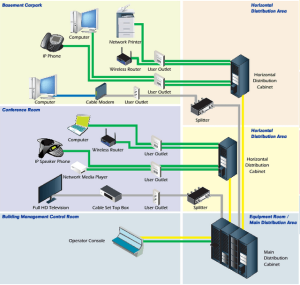Essential Issues in Design of Structured Cabling Systems
 Structured cabling systems (SCS) refers to the local area network cabling system designed exclusively to fit a company’s requirements. It combines data, voice, video, and management systems sometimes including alarm and security. SCS insures that all of this information is transmitted promptly and efficiently. The structured cabling system normally includes transmission products with engineering design rules that create a stable transmission system.
Structured cabling systems (SCS) refers to the local area network cabling system designed exclusively to fit a company’s requirements. It combines data, voice, video, and management systems sometimes including alarm and security. SCS insures that all of this information is transmitted promptly and efficiently. The structured cabling system normally includes transmission products with engineering design rules that create a stable transmission system.
Network Foundation
The structured cabling system is said to be the groundwork of a successful building and office setup. It is also the fundamental foundation on which all other equipment relies on.
It is not vendor-specific or reliant on topography. Established industry standards make for a stable office cabling infrastructure. We never recommend leading edge technology. We always go with what is established and working. With this type of cabling attitude, you benefit from consistency, adaptability, scalability, low-cost changes, and asset investment protection. What has emerged is a general platform for multiple information technology applications which include telecommunications, building automation and security (Closed Circuit Television/access control); videoconferencing systems, and fire safety systems.
Upside of a High-performance Network
The cabling system separates the whole infrastructure into systematic sections. It then incorporates these sub-systems to create a high-performance set of connections that serves as the link for numerous data hubs. The configuration supports apps that should require minimal upgrade. With a high-quality network, it is also easy to troubleshoot malfunctions and to fix problems while minimizing downtime.
A solid cabling system creates a dependable infrastructure across the network and even between buildings. And uniformity will result in cost savings by shortening the maintenance processes and providing consistency. And by sticking to existing standards, we get the flexibility to support different applications and hardware from various vendors. This methodology creates an efficient installation and makes it possible to effectively test and manage.
The “structured” features of this system makes administration and management less strenuous by providing centralized points of distribution .We also incorporate labeling and cabling management to insure that every cable is accounted for and to ease in tracking down problems if/when they arise. You should be able to look at a wallplate connector and see a code that corresponds to it’s connection at a patch panel in the computer wall closet.

Crowded Improperly Designed Structured Cabling Rack
Sometimes data facility managers opt for a more dynamic approach by populating the wiring racks with Information Technology (IT) equipment. This design accommodates will serve a business well by centralizing the core IT components with the structured cabling system. Nonetheless, data managers can respond only as quickly as the accessibility of this equipmen. So, be sure you over design the rack capacity so that it doesn’t get too crowded.
Identify Essential Issues
There are several issues to take into consideration in this process.
- Identify service providers available for the job site.
- Establish routes for bringing the service into the facility.
- Synchronize the point of entrance for each service provider.
- Consider equipment requirements and allot space for all service components.
This process is crucial in reducing the problems of the completed structured cabling system. Call or email us if you need help.

